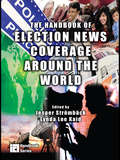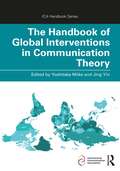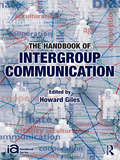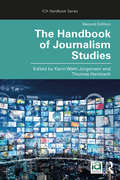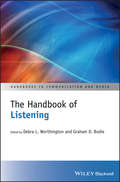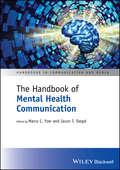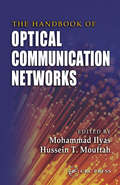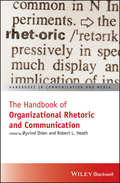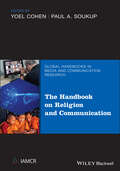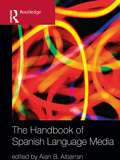- Table View
- List View
The Handbook of Drone Photography: A Complete Guide to the New Art of Do-It-Yourself Aerial Photography
by Chase GuttmanDrones are the next frontier in photography. This cutting-edge technology, still unexplored by the masses, can bring visual artistry to new and exciting heights. The Handbook of Drone Photography will be the go-to manual for consumers wishing to harness the power of drones to capture stunning aerial photographs.This book covers everything one needs to choose the right drone, to get airborne, and to capture and share incredible content. With easy and straightforward instruction, the text will familiarize readers with their craft and its controls. Readers will master drones’ extraordinary image-capturing capabilities and review detailed photography tips that can bring their artistic vision to life. For the first time, aerial photography is open to everyone, and award-winning travel photographer Chase Guttman will guide readers’ drone ventures from beginning to end. The Handbook of Drone Photography can help anyone break into this thrilling, high-potential space and launch their own lofty explorations today.
The Handbook of Election News Coverage Around the World (ICA Handbook Series)
by Jesper Strömbäck Lynda Lee KaidThe Handbook of Election Coverage Around the World focuses on the news coverage of national elections in democracies around the globe. It brings together and compares election news coverage within a single framework, offering a systematic consideration of various factors. Considering the prominence and power of the press in the election process, this volume will offer unique breadth in its global consideration of the topic. The volume will appeal to scholars in political communication, political science, mass media and society, and others studying elections and media coverage around the world.
The Handbook of Financial Communication and Investor Relations
by Alexander V. LaskinThe first book to offer a global look at the state-of-the-art thinking and practice in investor relations and financial communication Featuring contributions from leading scholars and practitioners in financial communication and related fields--including public relations, corporate communications, finance, and accounting-- this volume in the critically acclaimed "Handbooks in Communication and Media" seriesprovides readers with a comprehensive, up-to-date picture of investor relations and financial communications as they are practiced in North America and around the world. The Handbook of Financial Communication and Investor Relations provides an overview of the past, present, and future of investor relations and financial communications as a profession. It identifies the central issues of contemporary investor relations and financial communications practice, including financial information versus non-financial information, intangibles, risk, value, and growth. Authors address key topics of concern to contemporary practitioners, such as socially responsible investing, corporate governance, shareholder activism, ethics, and professionalism. In addition, the book arms readers with metrics and proven techniques for reliably measuring and evaluating the effectiveness of investor relations and financial communications. Bringing together the most up-to-date research on investor relations and financial communication and the insights and expertise of an all-star team of practitioners, The Handbook of Financial Communication and Investor Relations: Explores how the profession is practiced in various regions of the globe, including North America, South America, Europe, the Middle East, India, Australia, and other areas Provides a unique look at financial communication as it is practiced beyond the corporate world, including in families, the medical profession, government, and the not-for-profit sector Addresses "big-picture" strategies as well as specific tactics for financial communication during crises, the use of social media, dealing with shareholder activism, integrated reporting and CSR, and more This book makes an ideal reference resource for undergrads and graduate students, scholars, and practitioners studying or researching investor relations and financial communication across schools of communication, journalism, business, and management. It also offers professionals an up-to-date, uniquely holistic look at best practices in financial communication investor relations worldwide.
The Handbook of Gender, Sex, and Media (Handbooks in Communication and Media #24)
by Karen RossThe Handbook of Gender, Sex and Media offers original insights into the complex set of relations which exist between gender, sex, sexualities and the media, and in doing so, showcases new research at the forefront of media and communication practice and theory. Brings together a collection of new, cutting-edge research exploring a number of different facets of the broad relationship between gender and media Moves beyond associating gender with man/woman and instead considers the relationship between the construction of gender norms, biological sex and the mediation of sex and sexuality Offers genuinely new insights into the complicated and complex set of relations which exist between gender, sex, sexualities and the media Essay topics range from the continuing sexism of TV advertising to ways in which the internet is facilitating the (re)invention of our sexual selves.
The Handbook of Global Health Communication (Handbooks in Communication and Media #29)
by Silvio Waisbord Rafael ObregonInternational in scope, The Handbook of Global Health Communication offers a comprehensive and up-to-date analysis of the role of communication processes in global public health, development and social change Brings together 32 contributions from well-respected scholars and practitioners in the field, addressing a wide range of communication approaches in current global health programs Offers an integrated view that links communication to the strengthening of health services, the involvement of affected communities in shaping health policies and improving care, and the empowerment of citizens in making decisions about health Adopts a broad understanding of communication that goes beyond conventional divisions between informational and participatory approaches
The Handbook of Global Interventions in Communication Theory (ICA Handbook Series)
by Yoshitaka MiikeMoving beyond the U.S.-Eurocentric paradigm of communication theory, this handbook broadens the intellectual horizons of the discipline by highlighting underrepresented, especially non-Western, theorists and theories, and identifies key issues and challenges for future scholarship. Showcasing diverse perspectives, the handbook facilitates active engagement in different cultural traditions and theoretical orientations that are global in scope but local in effect. It begins by exploring past efforts to diversify the field, continuing on to examine theoretical concepts, models, and principles rooted in local cumulative wisdom. It does not limit itself to the mass-interpersonal communication divide, but rather seeks to frame theory as global and inclusive in scope. The book is intended for communication researchers and advanced students, with relevance to scholars with an interest in theory within information science, library science, social and cross-cultural psychology, multicultural education, social justice and social ethics, international relations, development studies, and political science.
The Handbook of Intercultural Discourse and Communication (Blackwell Handbooks in Linguistics #90)
by Elizabeth S. Rangel Scott F. Kiesling Christina Bratt PaulstonThe Handbook of Intercultural Discourse and Communication brings together internationally-renowned scholars from a range of fields to survey the theoretical perspectives and applied work, including example analyses, in this burgeoning area of linguistics. Features contributions from established researchers in sociolinguistics and intercultural discourse Explores the theoretical perspectives underlying work in the field Examines the history of the field, work in cross-cultural communication, and features of discourse Establishes the scope of this interdisciplinary field of study Includes coverage on individual linguistic features, such as indirectness and politeness, as well as sample analyses of IDC exchanges
The Handbook of Intergroup Communication (ICA Handbook Series)
by Michael Hogg Howard Giles Miles Hewstone Jake Harwood Cynthia Gallois Scott A. Reid John C. TurnerThe Handbook of Intergroup Communication brings together research, theory and application on traditional as well as innovative intergroup situations, exploring the communication aspect of these groups. The volume is organized into four domains – cross-disciplinary approaches to intergroup study; types/processes of communication between groups; communication between specific group types; and arenas in which intergroup communication takes place. Editor Howard Giles worked with an internationally-based advisory board to develop and review content, and the contributors included here represent those scholars doing innovative and well-regarded work around the globe. The "intergroup" umbrella integrates and transcends many traditional conceptual boundaries in communication (including media, health, intercultural, organizational); hence the Handbook will appeal to scholars and graduate students not only in the core area of intergroup communication itself, but across varying terrains of study in communication and beyond, including intergroup relations and social psychology.
The Handbook of International Advertising Research (Handbooks in Communication and Media)
by Hong ChengThis timely handbook brings academic excellence to international advertising research in the form of 28 contributions from over 40 leading scholars. The handbook’s comprehensive treatment highlights existing knowledge, reports major findings across the subject, and recommends directions and agendas for future research. Fills the existing gap between the rapid growth in scholarly research on international advertising and the pressing need for more high-quality research in the area Covers 28 major areas in international advertising research, with contributions from more than 40 international advertising scholars based in over 10 countries or territories Comprehensive treatment includes the history of international advertising, audiences and media, strategy and execution, content effects, regulation, ethics, and advertising education Highlights existing knowledge in international advertising, reports major findings on a broad range of topics, and offers expert recommendations on directions for future research Contributors represent the most highly respected academics among international advertising researchers
The Handbook of International Trends in Environmental Communication (ICA Handbook Series)
by Bruno TakahashiThis handbook provides a comprehensive review of communication around rising global environmental challenges and public action to manage them now and into the future. Bringing together theoretical, methodological, and practical chapters, this book presents a unique opportunity for environmental communication scholars to critically reflect on the past, examine present trends, and start envisioning exciting new methodologies, theories, and areas of research. Chapters feature authors from a wide range of countries to critically review the genesis and evolution of environmental communication research and thus analyze current issues in the field from a truly international perspective, incorporating diverse epistemological perspectives, exciting new methodologies, and interdisciplinary theoretical frameworks. The handbook seeks to challenge existing dominant perspectives of environmental communication from and about populations in the Global South and disenfranchised populations in the Global North. The Handbook of International Trends in Environmental Communication is ideal for scholars and advanced students of communication, sustainability, strategic communication, media, environmental studies, and politics.
The Handbook of International Trends in Environmental Communication (ICA Handbook Series)
by Bruno TakahashiThis handbook provides a comprehensive review of communication around rising global environmental challenges and public action to manage them now and into the future. Bringing together theoretical, methodological, and practical chapters, this book presents a unique opportunity for environmental communication scholars to critically reflect on the past, examine present trends, and start envisioning exciting new methodologies, theories, and areas of research. Chapters feature authors from a wide range of countries to critically review the genesis and evolution of environmental communication research and thus analyze current issues in the field from a truly international perspective, incorporating diverse epistemological perspectives, exciting new methodologies, and interdisciplinary theoretical frameworks. The handbook seeks to challenge existing dominant perspectives of environmental communication from and about populations in the Global South and disenfranchised populations in the Global North.The Handbook of International Trends in Environmental Communication is ideal for scholars and advanced students of communication, sustainability, strategic communication, media, environmental studies, and politics.
The Handbook of Journal Publishing
by Margaret Reich Sally Morris Ed Barnas Douglas LafrenierThe Handbook of Journal Publishing is a comprehensive reference work written by experienced professionals, covering all aspects of journal publishing, both online and in print. Journals are crucial to scholarly communication, but changes in recent years in the way journals are produced, financed, and used make this an especially turbulent and challenging time for journal publishers - and for authors, readers, and librarians. The Handbook offers a thorough guide to the journal publishing process, from editing and production through marketing, sales, and fulfilment, with chapters on management, finances, metrics, copyright, and ethical issues. It provides a wealth of practical tools, including checklists, sample documents, worked examples, alternative scenarios, and extensive lists of resources, which readers can use in their day-to-day work. Between them, the authors have been involved in every aspect of journal publishing over several decades and bring to the text their experience working for a wide range of publishers in both the not-for-profit and commercial sectors.
The Handbook of Journalism Studies (ICA Handbook Series)
by Karin Wahl-Jorgensen Thomas HanitzschThis second edition of The Handbook of Journalism Studies explores the current state of research in journalism studies and sets an agenda for future development of the field in an international context. The volume is structured around theoretical and empirical approaches to journalism research and covers scholarship on news production; news content; journalism and society; journalism and culture; and journalism studies in a global context. As journalism studies has become richer and more diverse as a field of study, the second edition reflects both the growing diversity of the field, and the ways in which journalism itself has undergone rapid change in recent years. Emphasizing comparative and global perspectives, this new edition explores: Key elements, thinkers, and texts Historical context Current state of the field Methodological issues Merits and advantages of the approach/area of study Limitations and critical issues of the approach/area of study Directions for future research Offering broad international coverage from world-leading contributors, this volume is a comprehensive resource for theory and scholarship in journalism studies. As such, it is a must-have resource for scholars and graduate students working in journalism, media studies, and communication around the globe.
The Handbook of Listening: Methodology And Measures (Handbooks in Communication and Media)
by Debra L. Worthington Graham D. BodieThe Handbook of Listening is a comprehensive overview of the field of listening for advanced undergraduate students, graduate students, scholars, and practitioners. First comprehensive academic reference resource dedicated to listening Provides a broad, authoritative, cross-disciplinary overview of key methodological, conceptual, and theoretical issues in the field Covers methods; disciplinary foundations; teaching listening; contexts and applications; and emerging perspectives Original chapters written by a group of international scholars in the field of learning
The Handbook of Mental Health Communication
by Jason T. Siegel Marco C. YzerThe first book of its kind to offer a transdisciplinary exploration of mass communication approaches to mental health In the Handbook of Mental Health Communication, a panel of leading scholars from multiple disciplines presents a comprehensive overview of theory and research at the intersection of mass communication and mental health. With timely and authoritative coverage of the impact of message-based mental health promotion, this unique volume places mental health communication in the context of socio-cultural causes of mental illness — synthesizing public health, psychopathology, and mass communication scholarship into a single volume. Throughout the Handbook, nearly one hundred contributing authors emphasize that understanding communication effects on mental health outcomes begins with recognizing how people across the spectrum of mental illness process relevant information about their own mental health. Fully integrated chapters collectively translate biased information attention, interpretation, and memory in mental health illness to real-world implications of mental illness symptomatology and across the spectrum of mental health issues and disorders. Providing a clear, evidence-based picture of what mental health promotion should look like, The Handbook of Mental Health Communication is an invaluable resource for advanced undergraduate and graduate students, scholars, researchers, lecturers, and all health communication practitioners.
The Handbook of Negotiation and Culture
by Michele J. GelfandIn the global marketplace, negotiation frequently takes place across cultural boundaries, yet negotiation theory has traditionally been grounded in Western culture. This book, which provides an in-depth review of the field of negotiation theory, expands current thinking to include cross-cultural perspectives. The contents of the book reflect the diversity of negotiation—research-negotiator cognition, motivation, emotion, communication, power and disputing, intergroup relationships, third parties, justice, technology, and social dilemmas—and provides new insight into negotiation theory, questioning assumptions, expanding constructs, and identifying limits not apparent from working exclusively within one culture. The book is organized in three sections and pairs chapters on negotiation theory with chapters on culture. The first part emphasizes psychological processes—cognition, motivation, and emotion. Part II examines the negotiation process. The third part emphasizes the social context of negotiation. A final chapter synthesizes the main themes of the book to illustrate how scholars and practitioners can capitalize on the synergy between culture and negotiation research.
The Handbook of Optical Communication Networks
by Hussein T. Mouftah Mohammad IlyasThe Internet revolution. Once, the public was delighted with 14.4 modem access and fascinated by low-tech Web site content. But not for long. Technology has raced to keep up with users' calls for high-speed facilities and advanced applications. With the development of high-speed transmission media and the availability of high-speed hardware, we are
The Handbook of Organizational Rhetoric and Communication (Handbooks in Communication and Media)
by Yvind Ihlen X00D8 Robert L HeathA one-stop source for scholars and advanced students who want to get the latest and best overview and discussion of how organizations use rhetoric While the disciplinary study of rhetoric is alive and well, there has been curiously little specific interest in the rhetoric of organizations. This book seeks to remedy that omission. It presents a research collection created by the insights of leading scholars on rhetoric and organizations while discussing state-of-the-art insights from disciplines that have and will continue to use rhetoric. Beginning with an introduction to the topic, The Handbook of Organizational Rhetoric and Communication offers coverage of the foundations and macro-contexts of rhetoric—as well as its use in organizational communication, public relations, marketing, management and organization theory. It then looks at intellectual and moral foundations without which rhetoric could not have occurred, discussing key concepts in rhetorical theory. The book then goes on to analyze the processes of rhetoric and the challenges and strategies involved. A section is also devoted to discussing rhetorical areas or genres—namely contextual application of rhetoric and the challenges that arise, such as strategic issues for management and corporate social responsibility. The final part seeks to answer questions about the book’s contribution to the understanding of organizational rhetoric. It also examines what perspectives are lacking, and what the future might hold for the study of organizational rhetoric. Examines the advantages and perils of organizations that seek to project their voices in order to shape society to their benefits Contains chapters working in the tradition of rhetorical criticism that ask whether organizations’ rhetorical strategies have fulfilled their organizational and societal value Discusses the importance of obvious, traditional, nuanced, and critically valued strategies such as rhetorical interaction in ways that benefit discourse Explores the potential, risks, paradoxes, and requirements of engagement Reflects the views of a team of scholars from across the globe Features contributions from organization-centered fields such as organizational communication, public relations, marketing, management, and organization theory The Handbook of Organizational Rhetoric and Communication will be an ideal resource for advanced undergraduate students, graduate students, and scholars studying organizational communications, public relations, management, and rhetoric.
The Handbook of Public Sector Communication (Handbooks in Communication and Media #91)
by Vilma Luoma-Aho María‐José CanelA multidisciplinary collection on global public entity strategic communication Research into public sector communication investigates the interaction between public and governmental entities and citizens within their sphere of influence. Today’s public sector organizations are operating in environments where people receive their information from multiple sources. Although modern research demonstrates the immense impact public entities have on democracy and societal welfare, communication in this context is often overlooked. Public sector organizations need to develop “communicative intelligence” in balancing their institutional agendas and aims of public engagement. The Handbook of Public Sector Communication is the first comprehensive volume to explore the field. This timely, innovative volume examines the societal role, environment, goals, practices, and development of public sector strategic communication. International in scope, this handbook describes and analyzes the contexts, policies, issues, and questions that shape public sector communication. An interdisciplinary team of leading experts discusses diverse subjects of rising importance to public sector, government, and political communication. Topics include social exchange relationships, crisis communication, citizen expectations, measuring and evaluating media, diversity and inclusion, and more. Providing current research and global perspectives, this important resource: Addresses the questions public sector communicators face today Summarizes the current state of public sector communication worldwide Clarifies contemporary trends and practices including mediatization, citizen engagement, and change and expectation management Addresses global challenges and crises such as corruption and bureaucratic roadblocks Provides a framework for measuring communication effectiveness Requiring minimal prior knowledge of the field, The Handbook of Public Sector Communication is a valuable tool for academics, students, and practitioners in areas of public administration, public management, political communication, strategic and organizational communication, and related fields such as political science, sociology, marketing, journalism, and globalization studies.
The Handbook of Religion and Communication (Global Handbooks in Media and Communication Research)
by Yoel Cohen Paul A. SoukupProvides a contemporary view of the intertwined relationship of communication and religion The Handbook on Religion and Communication presents a detailed investigation of the complex interaction between media and religion, offering diverse perspectives on how both traditional and new media sources continue to impact religious belief and practice across multiple faiths around the globe. Contributions from leading international scholars address key themes such as the changing role of religious authority in the digital age, the role of media in cultural shifts away from religious institutions, and the ways modern technologies have transformed how religion is communicated and portrayed. Divided into five parts, the Handbook opens with a state-of-the-art overview of the subject’s intellectual landscape, introducing the historical background, theoretical foundations, and major academic approaches to communication, media, and religion. Subsequent sections focus on institutional and functional perspectives, theological and cultural approaches, and new approaches in digital technologies. The essays provide insight into a wide range of topics, including religious use of media, religious identity, audience gratification, religious broadcasting, religious content in entertainment, films and religion, news reporting about religion, race and gender, the sex-religion matrix, religious crisis communication, public relations and advertising, televangelism, pastoral ministry, death and the media, online religion, future directions in religious communication, and more. Explores the increasing role of media in creating religious identity and communicating religious experience Discusses the development and evolution of the communication practices of various religious bodies Covers all major media sources including radio, television, film, press, digital online content, and social media platforms Presents key empirical research, real-world case studies, and illustrative examples throughout Encompasses a variety of perspectives, including individual and institutional actors, academic and theoretical areas, and different forms of communication media Explores media and religion in Judeo-Christian traditions, Islam, Buddhism, Hinduism, religions of Africa, Atheism, and others The Handbook on Religion and Communication is an essential resource for scholars, academic researchers, practical theologians, seminarians, mass communication researchers, and undergraduate and graduate students taking courses on media and religion.
The Handbook of Spanish Language Media
by Alan AlbarranWith the rise of Spanish language media around the world, The Handbook of Spanish Language Media provides an overview of the field and its emerging issues. This Handbook will serve as the definitive source for scholars interested in this emerging field of study; not only to provide background knowledge of the various issues and topics relevant to Spanish language media, but also to establish directions for future research in this rapidly growing area. This volume draws on the expertise of authors and collaborators across the globe. The book is an essential reference work for graduate students, scholars, and media practitioners interested in Spanish language media, and is certain to influence the course of future research in this growing and increasingly influential area.
The Harcourt Brace Guide to Documentation and Writing in the Disciplines (4th edition)
by Laurie G. Kirszner Stephen R. MandellPreparing to write for research; developing an argument; writing in the humanities, social sciences, natural sciences, and business; overview of documentation styles for books and articles
The Harlan Ellison Hornbook: Essays
by Harlan EllisonA major collection of Harlan Ellison's incomparable, troublemaking, uncompromising, confrontational essays and newspaper columns, The Harlan Ellison Hornbook mines deep into the author's colorful past. Failed love affairs, departed pets, a defense of comic books--in lesser hands, these subjects would be pabulum or treacle. When Harlan Ellison is behind the typewriter, the mundane becomes an all-out intellectual brawl. Emotionally moving and verbally stimulating, these columns cannot be missed, especially Ellison's article on controversial comedian Lenny Bruce or the chilling account of the author's trip to visit a death row inmate in San Quentin State Prison.
The Healing Heart—Families: Storytelling to Encourage Caring and Healthy Families
by Allison M. Cox and David H. AlbertStories and narratives aimed at helping families work through an array of subjects like health, illness, grief, adoption, sexual identity, and school.The Healing Heart provides powerful examples of the use of stories and storytelling in encouraging resiliency, empathy, respect, and healing. These engaging books contain stories, and narratives about the use of the stories in activities with different populations (children, teens, those with disabilities, seniors, inmates, etc.) or which address specific social or community problems (addictions, poverty, violence, racism, environmental degradation, homelessness, abuse).The books are a collective effort containing the expertise of more than 60 storytellers and health professionals who illustrate the power of story in moving others to commitment and action, in building self-esteem and mutual respect.The Healing Heart ~ Families focuses on families, dealing specifically with healing through story, health promotion, disease prevention, early childhood intervention, children with medical problems, adopting families, schools, sexual identities, grief, and spiritual healing. The Healing Heart ~ Communities focuses on community-building, with sections on youth, violence prevention, poverty, domestic violence, substance abuse and addiction, racism, elders, culture, environmental protection, homelessness, and community development.Praise for The Healing Heart ~ Families“Both children and adults, sick or well, need the embrace of soulful storytelling. They need to witness and be witnessed, for it is in this state that healing occurs . . . . If newscasters were to read aloud each night to their listeners for 1,001 nights one of the stories from this treasury, we would all be healed and lose our fear, recapturing real security in our homeland.” —N. Michael Murphy, MD, author of The Wisdom of Dying“An extraordinary work . . . . Hit the bulls eye by providing both process and practice. Thought provoking and insightful theory is intertwined with appropriate stories for direct application. It makes clear that story can be a powerful catalyst for change, giving eloquent voice to what many of us have known for some time but have been unable to express. What a gift for those who work with families!” —Elizabeth Ellis, co-author of Inviting the Wolf In: Thinking about Difficult Stories
The Hearsts: Father and Son
by William Hearst<p>From San Juan Hill to San Simeon, from Patton's tanks to the Symbionese Liberation Army, the Hearst name has been at the forefront of American life for over a century. <p>As founder of the largest U.S. prewar media empire, William Randolph Hearst, Sr., forever changed the face of American journalism by using his newspapers to aid in forcing the outbreak of the Spanish-American War. As a public figure he was larger than life, first as ambitious congressman, then as reclusive yet active businessman in the famous castle that rises above the Pacific at San Simeon. The elder Hearst was known for his extravagance as well as his long affair with Marion Davies, images that were highly embellished in Orson Welles' reproach of the Hearst persona, Citizen Kane. <p>In The Hearsts: Father and Son, William Randolph Hearst, Jr., and co-author Jack Casserly tell the extraordinary story of an American family from the gold-diggings of California to the present Hearst media empire. They also profile a cavalcade of reporters and columnists who became the stars of the Hearst newspapers, and portray the colorful New York nightlife of the 1930s and 1940s.</p>

